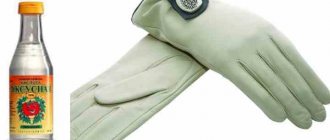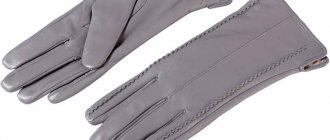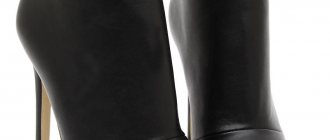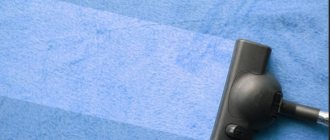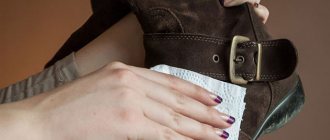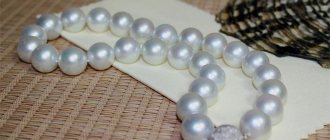Leather jacket care products
Products that maintain the safety of the jacket must be of high quality, safe and focused on caring for the skin type specified in the instructions. They are not universal and not interchangeable.
For example, smooth leather, which is the most wear-resistant, can be simply wiped with a damp cloth. Suede, on the contrary, is subjected to preliminary preparation, since it is less durable and requires systematic care. Nubuck requires special compounds that provide it with water resistance and strength.
Jacket care products are classified according to the frequency of cleaning, the specifics of leather products, protective, cleaning and conservation properties:
- Compositions for regular care: creams, impregnations, balms, conditioners, polishes, cleaning, hydrophobic, protective liquids and sprays.
- Specialized formulations: cream soaps, shampoos, foams, mousses, salt removal mixtures.
- Protective agents: water-repellent impregnations and wax mixtures.
- Specific compositions: softening mixtures, antibacterial sprays.
It is recommended to alternate products every few days.
Leather polish
No matter how carefully a person treats leather clothes, over time scratches, microcracks, and breaks appear on them.
Polish as a restoration agent is used to solve several problems:
- cleaning leather clothes;
- maintaining the strength, elasticity and softness of the product;
- protection of the product from mechanical damage;
- intensive nutrition;
- imparting water-repellent properties;
- extending the wear period of clothing.
The polishes contain natural waxes, extracts of non-toxic resins, selected and specialized oils (fatty impregnations), and emulsifiers. These highly purified products are odorless.
Transparent and colorless polish restores color saturation, adds shine and preserves the appearance of leather products.
Recommended for regular use.
Water repellents
Natural leather loses its elasticity under the influence of sunlight, changing temperatures, and changes in humidity. In this case, during use and long-term storage, the jacket must be treated with special conditioners, lotions and balms.
But prolonged exposure of leather products to rain and snow leads to excessive moisture. The jacket, when saturated with moisture, becomes deformed, dull and rough. Water stains are almost impossible to disguise.
Industrial wax for leather jackets made from environmentally friendly components of animal or plant origin moisturizes the material and at the same time creates a water-repellent (hydrophobic) layer.
Innovative impregnation Nano Protector is a product that creates a hydrophobic coating that prevents moisture absorption. The drug allows you to maintain a stable appearance without the risk of excessive moisture. The leather covering “breathes” at the same time.
Conditioners for leather products
To prevent deformation, roughness and dryness of the jacket, use conditioner. Its task is to restore the fat balance of overdried and tarnished material. The product is selected according to skin type and ingredients. Undesirable ingredients: wax, silicone, mineral oils.
Tips for suede
Suede clothing requires special and delicate care. The peculiarity of caring for it is proper dry cleaning and regular treatment with special products. To care for a suede leather jacket you will need:
- 1Universal impregnation for this type of leather, which will protect it from moisture and dirt. This product covers the fleecy surface and does not allow dust and other contaminants to penetrate deeply into the material. Thanks to these products, cleaning is quick and easy.
- 2Special eraser and brush. Remains of dust and dirt are removed from the skin only after it has completely dried. Using a brush with soft bristles, dirt is removed from the surface; it is worth cleaning in one direction, and not rubbing in one place. Then use an eraser to go over the entire surface to be cleaned. Using a springy sponge or brush, fluff the lint on the clothes and set it in one direction.
To remove greasy stains and greasy, worn-out areas on suede, you can use:
- 1Ammonia, take about 10 drops of alcohol per 250 ml of water. Use this solution to wipe the stain. After treatment, wipe the fabric with a clean damp cloth and dry the item. Drying must be done in a dry room, away from radiators.
- 2Vinegar can also cleanse the skin of greasy stains. Vinegar is diluted with water in the following proportion: add 15 ml of vinegar to 250 ml of water. Dip a cotton pad into this solution and wipe the stained areas with it. Residues are removed with a clean damp cloth.
- 3Dissolve hydrogen peroxide in water and wipe the jacket with this solution. Peroxide is added to 0.5 cups of water in the amount of 1 tsp.
We recommend: How to clean a shower stall at home
It happens that the pollution is quite complex, and these means and methods are not able to cope with them. In this case, you should not process leather products at home yourself, but the best solution would be to take the clothes to the dry cleaner.
If creases appear on a leather jacket, they can be removed with steam. To do this, fill the bath with hot water and hang the jacket over the water for 10 - 15 minutes. The vertical steam mode on the iron is also perfect; the main thing is to correctly calculate the distance and temperature on the device.
It is important to remember that before carrying out any cleaning measures on leather clothing, you should initially test them on the inside of the product, hidden from view.
How to care for a jacket using folk remedies
Caring for a leather jacket at home means cleaning, moisturizing and protecting. You need to react quickly to stains from juice, drinks, fat, or food. Old dirt, especially on husky, suede, and nubuck, will ruin the leather irrevocably.
If special industrial products are not available, use ammonia, castor oil, milk, vegetable oils, etc. Basic rules for caring for natural leather before using home remedies:
- Remove dirt with a damp (not wet!) sponge or cloth.
- Dry clothes at room temperature.
- Do not rub dirt.
- Apply care products to a dry and clean surface.
- Do not use homemade pastes, products containing abrasive microparticles, solvents, or shoe polishes.
- Apply products only with a soft cloth or a special brush.
- Polish the skin after applying the preparations with a flannel cloth or thin cloth.
All home remedies should be used carefully to avoid causing skin discoloration.
Ammonia and glycerin
Ammonia is used to remove grease stains. Do this carefully, lightly wiping the skin. When the substance disappears from the material, you need to treat the leather jacket with glycerin heated in a water bath.
The composition will help restore softness and elasticity to clothes.
Castor oil and egg white emollient
You can soften a leather jacket at home with an old folk remedy - castor oil (castor oil, castor oil). This impregnation is a natural preservative; it penetrates deeply into the fiber structure of the material, helping to maintain its elasticity and moisture.
To achieve a hydrophobic effect, 50 ml of castor oil is mixed with the white of 1 egg, whipped into a stiff foam. After stirring the composition until smooth, apply it to the skin.
Castor oil may cause darkening of fair skin tones.
Soap solution with fish oil and ammonia
A homemade remedy for softening leather clothes is prepared from the following ingredients:
- laundry soap - 100 g;
- hot water - 1 l;
- fish oil - 1 tsp. l.;
- ammonia - 3 tbsp. l.
Soap (it contains no dyes, preservatives, or fragrances) is grated and filled with water. When the mixture becomes homogeneous, add the remaining substances to it and mix thoroughly.
The resulting product is evenly distributed over the surface of the jacket using a cotton swab or a piece of foam rubber.
Butter and ammonia
A kind of cream for a leather jacket is prepared from a mixture of warm water, butter and ammonia in a ratio of 3:3:2. When the butter melts in water, ammonia is added to it. The components are mixed well until a homogeneous mixture is obtained and applied to the skin.
The cream cleanses, moisturizes and softens the skin.
Cleaning
Before using softening agents, it is necessary to clean the jacket from dirt.
The skin does not like excess moisture, so machine washing is not recommended. All procedures are performed manually using home or professional cleaning products.
If there are no stains, still go over the jacket with a damp cloth soaked in a soapy solution. Small particles of dust can scratch the product when you begin to rub in emollients.
Fat is removed using cornstarch or talc.
Remove lipstick stains with warm water and a sponge.
Under no circumstances should you use chemical solvents such as acetone, sulfuric acid, etc. Such products will not only harm the skin, but eventually you will have to throw away the jacket.
How to care for a white leather jacket
White leather jackets are striking and stylish. But even slight traces of dirt are immediately visible on them.
The white jacket is cleaned with soapy water, gently wiping off the dirt with a sponge, and wiped with a soft, dry cloth.
There are other home remedies.
Turpentine and cow's milk
A mixture of heated milk and turpentine will help clean and soften a white leather jacket. The components are taken randomly, but there should not be a lot of turpentine. The product is evenly applied to the material and dried, and then wiped with flannel or fleece cloth.
Stationery chalk or potato starch
Chalk or starch is diluted in water to a paste. The mixture is evenly applied to the jacket. After keeping the paste on the clothes for some time, it is carefully washed with a damp cloth. After drying slightly, wipe and apply glycerin to the jacket.
This method cleanses, whitens and softens the skin.
But chalk can contain invisible abrasive particles, so it's best to take an expensive white leather jacket to a professional for cleaning.
Body milk
The gentle body cleanser is also suitable for cleaning white skin. Milk is mixed with water in equal quantities. You should get a homogeneous mass, which is applied in a thin layer to the jacket.
The emulsion remains on the surface of the skin for 20-25 minutes, after which it is removed with a dry cloth.
Glycerol
Glycerin alone cannot be used as a separate emollient.
It is used in combination with beams, a slice of lemon and warm water.
How to soften the skin - algorithm of actions:
- First add the whipped whites. Leave for 4 hours. After the allotted time for the procedure has expired, remove with a damp cloth.
- The second step is to treat the surface with a slice of lemon. Can only be used on light-colored jackets, because the acid contained in this citrus has a bleaching effect. After two hours, the product is wiped again with a damp cloth, then dry.
- And the last - third step - applying glycerin. Soak a cotton pad or soft cloth in the oily liquid and wipe the skin. After 8 hours, the glycerin is also removed and conditioner is applied.
After such manipulation, the skin becomes softer and more elastic. The jacket is more pleasant to wear and does not cause discomfort.
How to properly clean and dry a leather jacket
Caring for a leather jacket is to prevent it from getting dirty, over-drying and over-wetting. But it is important to follow these rules:
- do not wear it in rainy or snowy weather;
- avoid sunlight;
- beware of frost;
- avoid carrying heavy objects in pockets and bags on the shoulder;
- Do not use stain removers or solvents due to possible damage to the skin.
Under no circumstances should you wash leather clothing in a washing machine or use solvents or detergents not intended for leather. This type of cleaning washes away fat, discolors, dries out the skin, and causes it to crack.
Clean it with a special leather brush with soft bristles or a damp soft cloth, avoiding strong friction. If necessary, use a soap solution.
After thorough cleansing, if there is no discoloration, use a balm to refresh the skin. When bleaching, apply appropriate dyes.
If you wear a leather jacket every day, you need to take care of it regularly. If it does get wet, then it is dried at room temperature away from heaters and sunlight. Rapid drying causes the leather to harden, warp and crack.
Clothes should be stored on a hanger with hangers proportional to the jacket, neatly buttoned. All zippers should be closed and collars and cuffs should be straightened.
After drying, the jacket is treated with leather care products and placed in a spacious “breathable” cover that protects the clothing from dust.
Reasons for rigidity
Before moving on to softening methods, it is necessary to understand why this happens with such material.
There are several possible reasons:
- The very first thing is the quality of the leather jacket. Always check with the seller what the leather is made of, what animal skin was used, whether it is really natural or not.
- The jacket becomes stiff if the item is not stored correctly. Most people put their outerwear in a common closet without considering the conditions in it. Leather should not be stored in a very damp place. Just like you shouldn’t place a jacket in a closet with low air humidity. Dry air literally sucks moisture out of your skin, making it hard. Optimal humidity is 40–50%.
Therefore, it is so important to adhere to the rules for storing and drying leather products after washing.

